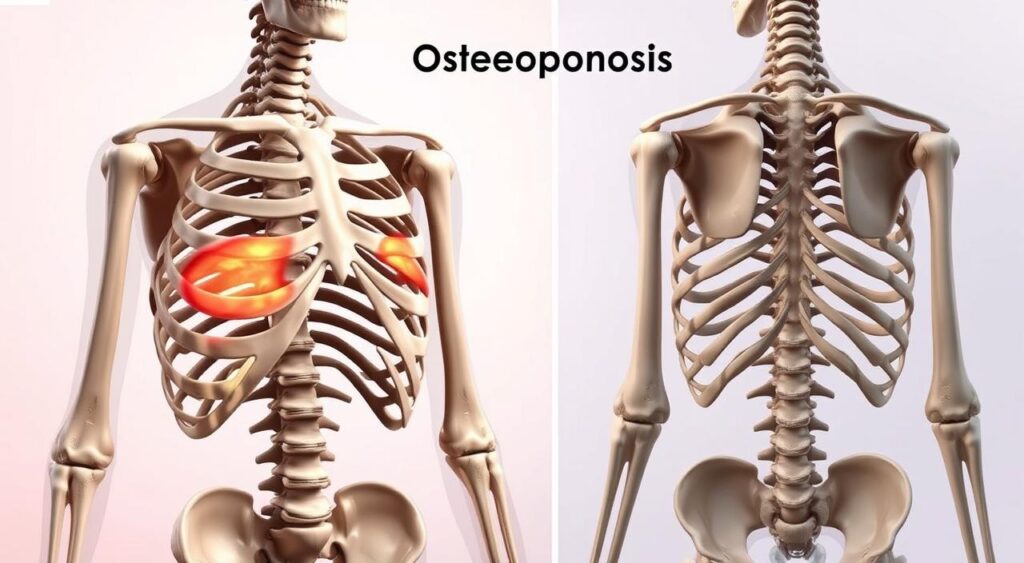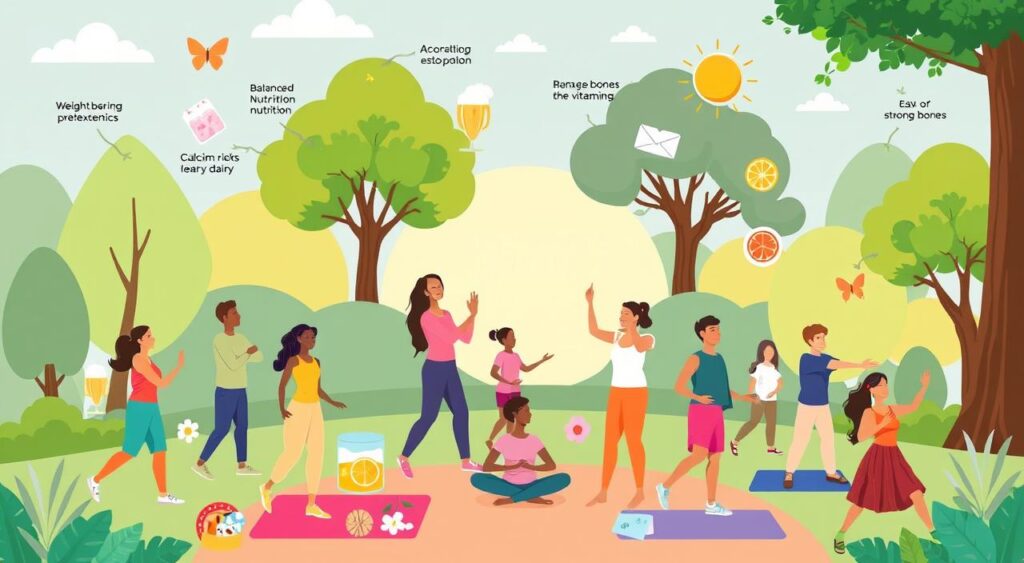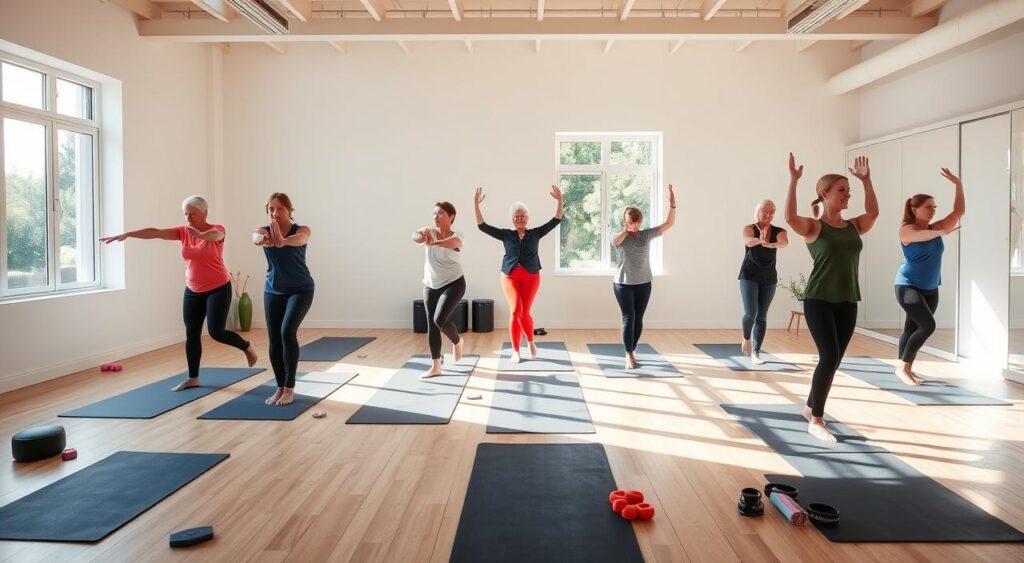Understand the fundamentals of osteoporosis, a condition that causes bones to weaken and become brittle. Get the facts on causes, symptoms, and treatment options.
Did you know that osteoporosis causes more than 8.9 million fractures worldwide every year? This silent disease weakens bones, making them fragile and prone to breaks. Understanding osteoporosis is the first step toward protecting your bone health.

Osteoporosis is a condition where bones lose density and strength, increasing the risk of fractures. It often goes unnoticed until a bone breaks, earning it the nickname “the silent bone disease.” Maintaining good bone health is crucial to preventing this condition and its life-altering effects.
Key Takeaways
- Osteoporosis weakens bones, making them more likely to fracture.
- It is often called “the silent bone disease” because it shows no symptoms until a break occurs.
- Over 8.9 million fractures worldwide are linked to osteoporosis each year.
- Bone health is essential for preventing osteoporosis and maintaining mobility.
- Early awareness and proactive measures can reduce the risk of osteoporosis.
Understanding Osteoporosis: The Silent Bone Disease
Osteoporosis makes bones weak and brittle, raising the chance of fractures. It’s often called the silent disease because it doesn’t show symptoms until a bone breaks. Knowing how bones work and how osteoporosis affects them is key to preventing and managing it.
Definition and Basic Concepts
Osteoporosis happens when bone density drops, making bones weak. This can occur when the body loses too much bone or doesn’t make enough. Low bone density can cause fractures even from small falls or bumps.
How Healthy Bones Function
Healthy bones are rebuilt constantly in a process called remodeling. Bone cells break down old bone and replace it with new tissue. This keeps bones strong and dense. If this process is disrupted, bones lose density and become more likely to fracture.
The Impact on Daily Life
Osteoporosis can greatly impact daily life. Fractures, especially in the hip, spine, or wrist, can cause pain, limited mobility, and loss of independence. Keeping bones dense through good nutrition and exercise is vital to lower fracture risk and enhance quality of life.
The Science Behind Bone Density
Bone density is how much mineral matter is in bones. Having strong bones is vital for health. It helps prevent conditions like osteoporosis. Two key nutrients are important: calcium and vitamin d.
Calcium is crucial for bone strength. It gives bones the power to handle daily stress. Vitamin d helps the body use calcium better. Without enough vitamin d, even more calcium won’t help.
- Age: Bone density reaches its peak in early adulthood and then starts to go down.
- Hormones: Hormonal changes, especially in women during menopause, can impact bone health.
- Lifestyle: Regular exercise and a diet full of calcium and vitamin d help keep bones strong.
Knowing about bone density helps us make better choices about what we eat and how we live. Focusing on calcium and vitamin d can lower the risk of osteoporosis. It’s key for keeping bones healthy for a long time.
Risk Factors for Developing Osteoporosis
Knowing the risk factors for osteoporosis is key to early detection and prevention. Factors like genetics, lifestyle, and medical conditions can raise your risk. It’s vital for women to focus on preventing osteoporosis, as they are more likely to lose bone density.
Genetic Factors
Family history is a big factor in osteoporosis risk. If a relative has it, you might be more likely to get it too. Genetics affect bone density and structure, making some more prone to it.
Lifestyle Influences
Our daily habits can either help or harm our bones. Smoking, too much alcohol, and a sedentary lifestyle can lead to bone loss. But, exercises that make you use your bones and a diet rich in calcium can help prevent it.
Medical Conditions
Some health issues, like hormonal imbalances and thyroid disorders, can weaken bones. Even certain medications, like corticosteroids, can increase the risk. Regular health check-ups and managing these conditions are crucial for women’s health and overall well-being.
Common Signs and Symptoms
Osteoporosis often goes unnoticed until a bone breaks. Spotting early signs is key to managing it and preventing more damage. Here are some symptoms to look out for:
- Back pain, caused by fractured or collapsed vertebrae.
- Loss of height over time due to spinal compression.
- A stooped posture, often referred to as a “dowager’s hump.”
- Bones that break more easily than expected, even from minor falls.
These symptoms show that bones are weakening, a sign of osteoporosis. Finding it early is important. It lets you take steps to make bones stronger and lower fracture risk. Regular health checks and bone density tests are vital, especially for those at higher risk.
If you see any of these signs, see a doctor. Treating osteoporosis early can greatly improve your life. It helps keep bones strong and healthy.
How Osteoporosis Affects Different Age Groups
Osteoporosis affects people in different ways based on their age. Knowing these differences helps us take steps to keep our bones healthy. Each age group has its own challenges and risks.
Young Adults and Bone Health
In young adulthood, bone density is at its strongest. It’s important to eat right and exercise to build strong bones. A diet full of calcium and vitamin D, along with activities that make bones stronger, is key. Skipping these habits can lead to osteoporosis later.
Middle-Age Concerns
As we get into middle age, our bones start to lose density. Hormonal changes, especially for women during menopause, speed up this loss. It’s important to get regular check-ups and make healthy lifestyle choices to slow bone loss.
Elderly Population Risks
For the elderly, osteoporosis can cause fractures and make it hard to move. Keeping bones strong is harder, so prevention is key. Training to improve balance and making homes safer can help prevent falls and keep bones strong.
By focusing on bone health at every age, we can lessen the effects of osteoporosis. This way, we can have stronger, healthier bones for a long time.
Diagnostic Methods and Testing
Early detection of osteoporosis is key to avoiding fractures and enhancing life quality. Several tests are used to check bone health and spot issues early. The Dual-Energy X-ray Absorptiometry (DEXA) scan is a common one. It measures bone density and predicts fracture risk.

- Quantitative Ultrasound (QUS): Checks bone density in the heel or shin.
- Blood Tests: Looks at calcium, vitamin D, and bone markers levels.
- FRAX Tool: Calculates fracture risk over 10 years based on risk factors.
Regular screenings are vital for osteoporosis prevention. They help doctors spot early bone loss signs. Then, they can suggest lifestyle changes or treatments to boost bone strength.
“Prevention is always better than cure, especially when it comes to bone health.”
Being proactive with tests helps keep bones strong and lowers fracture risk. Make sure to get regular check-ups and talk about bone health with your doctor. This way, you can stay ahead of osteoporosis.
The Role of Nutrition in Bone Health
Nutrition is key to keeping bones strong and preventing osteoporosis. Eating a balanced diet full of important nutrients boosts bone density and health. Calcium and vitamin d are crucial for bone strength, working together effectively.
Essential Nutrients for Strong Bones
Calcium is vital for bones, and vitamin d helps the body use calcium well. Magnesium, phosphorus, and vitamin K also play a role in bone health. Adding these to your diet can lower the risk of fractures and bone loss.
Dietary Recommendations
To get enough calcium, eat dairy, leafy greens, and fortified foods. Vitamin d comes from sunlight and foods like fatty fish and egg yolks. Here’s a table of daily nutrient needs:
| Nutrient | Daily Intake |
|---|---|
| Calcium | 1,000-1,200 mg |
| Vitamin D | 600-800 IU |
| Magnesium | 310-420 mg |
Supplements and Their Benefits
If diet alone can’t meet nutritional needs, supplements can help. Calcium and vitamin d supplements are common and can fill nutritional gaps. Always talk to a healthcare provider before starting supplements.
Treatment Options and Management Strategies
Managing osteoporosis well needs a mix of treatments that fit each person’s needs. Women’s health is key in preventing brittle bones. Starting treatment early can make a big difference. Here are some common treatments:
- Medications: Bisphosphonates, hormone therapy, and biologics slow bone loss and lower fracture risk.
- Calcium and Vitamin D: These nutrients strengthen bones and support bone health.
- Lifestyle Changes: Regular exercise, a balanced diet, and quitting smoking can boost bone density.
- Physical Therapy: It helps improve strength, balance, and posture to prevent falls.
For those at risk of brittle bones, being proactive is crucial. Regular bone density tests and talks with healthcare providers help adjust treatments on time. Mixing medical treatments with lifestyle changes is the best way to keep bones strong and reduce problems.
By focusing on women’s health and treating osteoporosis early, people can live active, happy lives. This way, they can lessen the effects of this condition.
Exercise and Physical Activity Guidelines
Staying active is key for keeping bones strong, especially for those with osteoporosis. Regular exercise makes bones stronger, improves balance, and lowers fracture risk. Here are some tips to help you stay active safely and effectively.

Weight-Bearing Exercises
Weight-bearing exercises are vital for bone health. Activities like walking, jogging, and dancing make your body work against gravity. This stimulates bone growth, which is great for managing osteoporosis.
Balance Training
Keeping your balance is crucial to avoid falls and fractures. Simple exercises like standing on one leg or doing tai chi can help. Balance training is important for bone health as you get older.
Safe Exercise Practices
When exercising with osteoporosis, safety comes first. Stay away from high-impact activities or movements that twist or bend your spine. Always talk to a healthcare professional before starting a new exercise routine. This ensures it meets your bone health needs.
Preventing Falls and Fractures
Falls are a major cause of fractures, especially for those with osteoporosis. To prevent this, we focus on reducing fall risks and protecting bones. Making simple changes in our daily lives and homes can greatly help.
Keeping our homes safe is key to preventing falls. We should remove tripping hazards like loose rugs or clutter. Also, installing grab bars in bathrooms and ensuring good lighting in hallways and staircases is important. These steps can make our living spaces safer.
Exercise is also crucial in preventing osteoporosis and fractures. Activities like yoga or tai chi can improve balance and strength, lowering fall risks. Weight-bearing exercises help keep bones strong, making them less likely to break.
- Wear supportive, non-slip footwear to reduce fall risks.
- Use assistive devices like canes or walkers if needed.
- Regularly review medications with a healthcare provider to avoid dizziness or imbalance.
Regular eye check-ups are also vital. Poor vision can lead to more falls. By staying proactive with health screenings and adopting these preventive measures, we can significantly lower fracture risks and improve our quality of life.
Living Well with Osteoporosis
Managing osteoporosis well means making daily habits, feeling good emotionally, and getting help from experts. Keeping your bones strong and getting enough calcium are key to a healthy life. Here are some tips and resources to help you do well.
Daily Management Tips
Small changes can make a big difference. Eat a diet full of calcium and vitamin D to help your bones. Do exercises that make your bones stronger, like walking or yoga. Also, don’t smoke and drink alcohol in moderation to protect your bones.
Emotional Support and Resources
Dealing with osteoporosis can be tough, but you’re not alone. Joining support groups or talking to others who face the same issues can help. Websites like the National Osteoporosis Foundation have lots of useful info and tools to keep you informed and strong.
Working with Healthcare Providers
Seeing your doctor regularly is very important. They can check your bone health and change your treatment if needed. Talk about your calcium intake and any supplements you’re taking to make sure they’re right for you. Being open with your healthcare team helps you get the best care.
- Prioritize calcium-rich foods like dairy, leafy greens, and fortified products.
- Engage in safe, bone-strengthening exercises regularly.
- Seek emotional support through community groups or counseling.
- Schedule routine visits with your healthcare provider for ongoing care.
Conclusion: Taking Control of Your Bone Health
Understanding osteoporosis is key to protecting your bones. Recognizing risk factors and symptoms early helps. Women’s health is especially important, as hormonal changes during menopause can speed up bone loss.
Regular check-ups and bone density tests are crucial. They help catch problems before they get worse. This way, you can take steps to keep your bones strong.
Vitamin D is vital for calcium absorption and bone health. Getting enough through sunlight, diet, or supplements can lower fracture risk. A diet rich in calcium and nutrients also supports strong bones.
Physical activity, especially weight-bearing exercises, boosts bone density. This improves your overall health.
Living with osteoporosis doesn’t mean you have to stop being active. Simple steps like making your home safer and doing balance exercises can help. Emotional support and resources are also key to managing the condition well.
Working closely with healthcare providers is important. They can give you personalized care and help you achieve better results.
Protecting your bone health is a lifelong effort. By staying informed and proactive, you can lessen osteoporosis’ impact. This way, you can enjoy a healthier, more active life.
FAQ
Q: What is osteoporosis?
A: Osteoporosis is a condition where bones weaken and thin. This makes bones more likely to break and become fragile.
Q: What are the symptoms of osteoporosis?
A: Early osteoporosis often has no symptoms. But, signs like back pain, losing height, and a curved back can appear later.
Q: Who is at risk of developing osteoporosis?
A: People at risk include older adults, especially women, and those with a family history. Low calcium, vitamin D, and a sedentary lifestyle also increase risk.
Q: How can I prevent osteoporosis?
A: Eating well, exercising regularly, and avoiding smoking and too much alcohol can help prevent osteoporosis.
Q: How is osteoporosis diagnosed?
A: Doctors use bone density tests, like a DXA scan, to diagnose osteoporosis. These tests measure bone density and risk of fractures.
Q: What are the treatment options for osteoporosis?
A: Treatments include lifestyle changes, medication, and supplements. This can include calcium, vitamin D, and hormone therapy.
Q: Can exercise help with osteoporosis?
A: Yes, exercises that strengthen bones can improve density. They also help prevent falls and fractures.
Q: How does nutrition affect bone health?
A: Eating enough calcium, vitamin D, and protein is key for strong bones. It helps prevent osteoporosis.
Q: How can I reduce the risk of falls and fractures?
A: To lower fall risk, make your home safe, practice balance, and join fall prevention programs. Good bone health through diet and exercise also helps.
Q: What resources are available for living with osteoporosis?
A: Support groups, educational resources, and healthcare providers offer help. They can improve life quality for those with osteoporosis.
